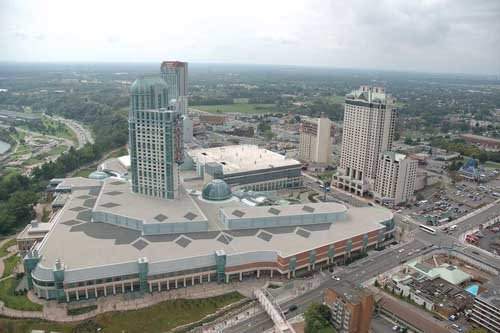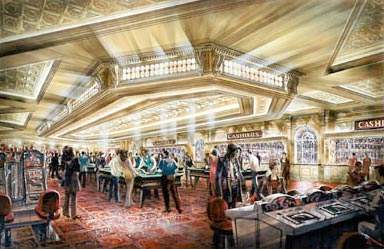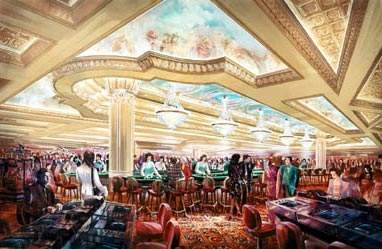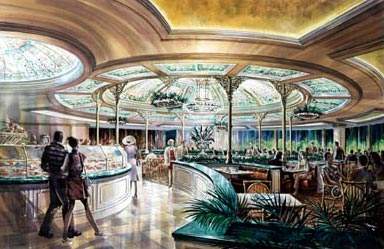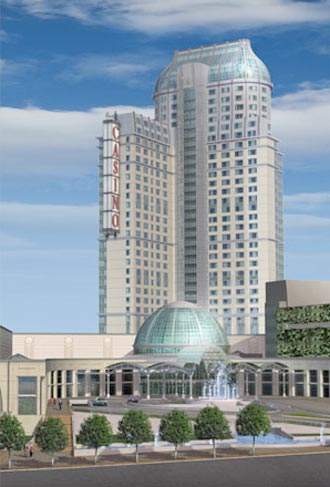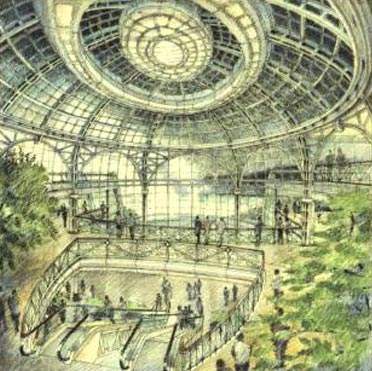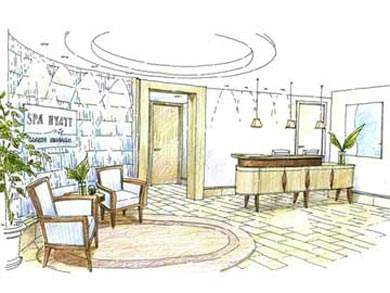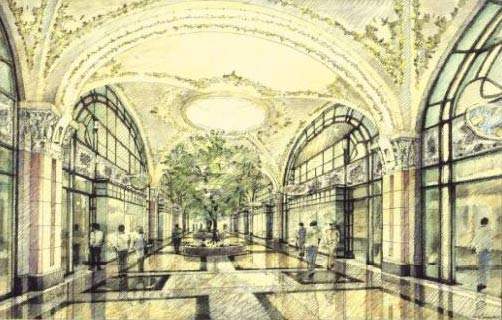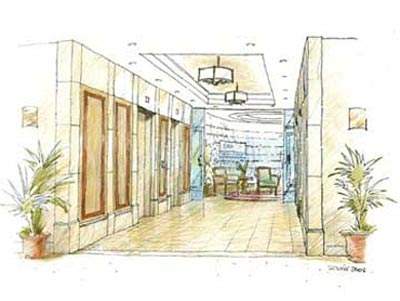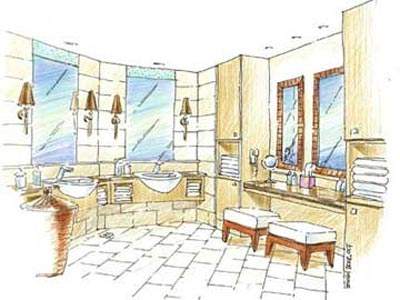The Niagara Falls Casino and Resort is one of the largest capital projects constructed in Ontario, Canada. First started in 2001, the project had a cost of $1 billion. The Ontario Lottery and Gaming Corporation chose a consortium of five gaming and real estate companies (including the Hyatt Hotel Group) called the Falls Management Company, to finance, design, build and operate the new casino and resort complex.
The site for the new casino was once the transformer station building for the Ontario Power Company station at the foot of Horseshoe Falls in Niagara. The plant was decommissioned in 1999 but parts of the building remain.
The east facade of the casino complex retains the walls of the terrace and front entrance of the transformer station built in 1904. The area where once the transformers generated power is now the Grand Hall Convention halls.
FLOOR SPACE, FACILITIES AND OPENING
The casino / hotel complex has a total floor space of 2.5 million ft². The complex consists of a 368-room Hyatt hotel with 32 floors and a conference, convention and exhibition centre with 50,000ft² of floor space, as well as a 1,500-seat theatre, a selection of ten restaurants, a galleria shopping centre complex, a wedding chapel, a heath / fitness spa area 15,000ft² (1,400m²) and a 3,000-space car parking facility.
The entertainment and retail section of the complex has 100,000ft² of floor space. The casino itself has a little over 200,000ft² of floor space – enough to accommodate 150 gaming tables, 3,000 slot machines and a 1,000 seat theatre.
The casino is owned by the Crown Agency – The Ontario Lottery and Gaming Corporation (a large portion of the profits are returned to the Ontario government). Planning for the resort was started by the Ontario Casino Corporation as soon as the temporary facility Casino Niagara was opened in 1996 on the site of the former Maple Leaf Village amusement park.
Construction began in 2001. The building phase of the resort and casino was completed in October 2003 and the complex opened officially on 10 June 2004. Due to market demand, the temporary facility has been kept open and continues to operate as of 2006. The temporary casino floor size is 100,000ft² (9,000m²) with 2,800 slot machines, 135 gaming tables, four restaurants and eight bars.
NIAGARA FALLS CASINO RESORT CONTRACTORS
The architects for the complex were Zeidler Roberts Partnership Architects and Bregman and Hamann Architects. The construction management was carried out by PCL Constructors Canada, Inc. The structural engineering was carried out by Yolles Partnership Inc, and the structural steel on the casino provided by the Canam Manac Group Inc.
The structural steel and civil engineering of the hotel and car park were the responsibility of Aluma Systems. Mechanical engineering was carried out by Hidi Rae Associates Inc and The Mitchell Partnership, and electrical engineering by Mulvey and Banani International.
The interior design was undertaken by Dougall Design Associates Inc and Moncur Design Associates Inc. The landscape design was contracted to Ferris Quinn Associates. Kramer Design Associates designed and constructed the sign for the casino to develop the brand identity.
NIAGARA FALLS CASINO RESORT DESIGN AND ARCHITECTURE
The Niagara Falls Casino Resort complex is located on a 22-acre site overlooking the Horseshoe Falls. The architectural features of the main building are a spacious foyer with a glass entrance dome and a porte cochere which leads into a glass-enclosed galleria, from which the falls may be viewed via the glass-enclosed rotunda area.
The galleria is a multipurpose area that leads to the gaming hall, the retail area, the foyer of the theatre and the hotel lobby. Escalators lead down from the galleria to a lower level where the restaurants are situated along with terraces with seating for customers to enjoy the view. The casino complex and other attractions in the immediate area are linked via a people mover system.
NIAGARA FALLS CASINO RESORT CONSTRUCTION
The structural steel of the casino construction (Canam Manac Group) involved some 7,500t of steel girders and 900,000ft² of steel deck. Also required was 200t of architectural steel to build the entranceways to the casino.
The civil engineering of the hotel tower complex required equipment from Aluma Systems, as did the construction of special core forms and platforms for the elevators of the tower.
ELECTRICAL ENGINEERING
The electrical systems were designed by Mulvey and Banani International. The design brief was to provide a system which could keep the facility operational 24 hours a day, 365 days per year. The system was to include a back-up in case of power outage from the electricity grid.
Usually a system such as this means the installation of tandem systems, one connected to the grid and the other to back-up generators. The system at the Niagara Falls resort uses a ‘parallel generation system’, which means the buildings have a single electrical system connected to the grid and to the resort’s three 2,000kW diesel generators.
The grid and the generators are connected by a state-of-the-art synchronising switchboard, which is designed to seamlessly allow the generators to provide power shortfall to the resort. In an emergency situation the generators acting alone have enough output to supply the gaming floor, emergency lighting and safety systems.
The generator system is also designed to reduce the resort’s demand on the grid during peak periods. If the generators produce more power than is required by the resort then surplus power is diverted to the grid and sold at a profit.
The security system at the resort consists of CCTV surveillance, access control and monitoring. This incorporates a state-of-the-art control centre, 2,000 cameras and 1,000 VCRs using the latest digital imaging technology.
NIAGARA FALLS CASINO RESORT AIR HANDLING SYSTEM
The air handling system was designed and installed by Hidi Rae Consulting Engineers and The Mitchell Partnership mechanical engineers. The system includes independent air systems to provide outdoor air ventilation to each hotel room, the spa, the theatres, the central kitchen and all the non-public areas.
The casino floor is served by ten air handling units that change the air across the entire floor every three to four minutes operating under a ‘once through’ supply and exhaust system. All contaminated air from the floor is exhausted to the outside and replaced with fresh air, thus eliminating any contaminants such as tobacco smoke and airborne bacteria.
The system is under direct digital control and monitoring to maximise the efficiency of the system across the whole resort. Computer testing simulations have shown that the system uses 30% less energy than the standard set by the Canadian Model National Energy Code.
COOLING AND HEATING
During warmer months, the resort is cooled by six electric centrifugal chillers that can supply 7,200t of cooling capacity. In the colder weather of the winter months the resort is heated by four 600hp natural gas fired boilers.
The heating system also distributes hot water to an extensive snow-melting system. This is a series of pipes embedded in the concrete of the entranceways and exterior walkways that melt ice and snow before it becomes a hazard to the guests. The same system supplies hot water to the resort’s fountain system making sure it can operate all year round.
NIAGARA FALLS CASINO RESORT LANDSCAPE FEATURES
Several large water features were built in the complex to complement the Niagara Falls themselves. The main entranceway to the resort has a stepped cascading fountain down to the street level incorporating 200 jet nozzles and 15ft-high columns of water, which erupt from the fountain surface.
A 16ft-wide promenade leads north-south from one end of the complex to the other, passing through woods and gardens that frame and enhance the views of the actual falls themselves.
At the centre of the promenade is a circular plaza with another major fountain – 13 jets built into a star pattern. The jets have been built flush with the surrounding piazza paving. The piazza is also able to provide a large protected area for outdoor events should the need arise.

